The Sigma USB Dock (UD-01) is a lens mount that allows you to connect some Sigma lenses to your computer via USB, to update the lens firmware, and customise some of the lens functions.
In other words, you can configure focus micro-adjustments in the lens itself, rather than in the camera body. For prime lenses, you can configure focus-adjustment settings at four different focus distances, and for zoom lenses, you can configure focus-adjustment settings at multiple focal lengths too.
On some Sigma lenses, you can also customise other settings, including auto-focus speed settings, focus distance limiter, optical stabilisation, and more.
For now, the Sigma USB dock is only compatible with Sigma's new Contemporary, Art and Sports lines of lenses. At the time of writing, the USB dock can be used with the following lenses:
- Sigma 35mm f/1.4 DG HSM
- Sigma 24-105mm f/4 DG OS HSM
- Sigma 120-300mm f/2.8 DG OS HSM
- Sigma 17-70mm f/2.8-4 DC Macro OS HSM
- Sigma 30mm f/1.4 DC HSM
- Sigma 18-35mm f/1.8 DC HSM
- update the lens firmware
- adjust focus settings at 4 focus distances
- adjust focus settings at 4 focal lengths (at each of 4 focus distances, so a total of 16 focus settings)
- adjust optical stabilisation (OS) settings
- adjust auto-focus speed
- customise focus limits
- configure custom settings selectable via a switch on the lens barrel
The Sigma USB dock is available in three flavours - for Sigma-mount lenses, for Canon-mount lenses, and for Nikon-mount lenses. Each dock is specific to that mount - ie, you need a USB dock for Canon mount to be able to connect a Sigma lens with a Canon mount, and similarly for the Sigma mount and Nikon mount lenses.
In the box you get the USB dock, a USB cable with a UC-E6 proprietary (non-USB) connector, and some assorted paperwork.
The dock itself looks like an extra-thick rear lens cap, with a locking lever, an indicator LED in the centre, and a USB socket. Also included is a body cap, used for protecting the contacts on the USB dock when not in use.
Rather than using a micro-USB or mini-USB connector, Sigma have chosen to use a UC-E6 connector for connecting the USB cable to the dock itself.
No software is included with the USB dock - you need to download the Sigma Optimisation Pro software from Sigma's website. The software is available for Windows 7 and 8, and also for Mac OS X 10.7 and 10.8.
The Windows version of the Sigma Optimisation Pro software is a 21MB download (for version 1.1.0, which was the latest available version at the time of writing).
Before making any calibration adjustments to your lens, take some photos using a wide aperture at each of the focus distances that adjustments can be applied: 0.3 metres, 0.4 metres, 0.7 metres and infinity. View these photos on your computer to determine if the lens is rear-focusing or front-focusing at each of these distances.
I find taking photos of a ruler or measuring tape allows you to easily see where the lens has focused, as shown in the annotated photo below.
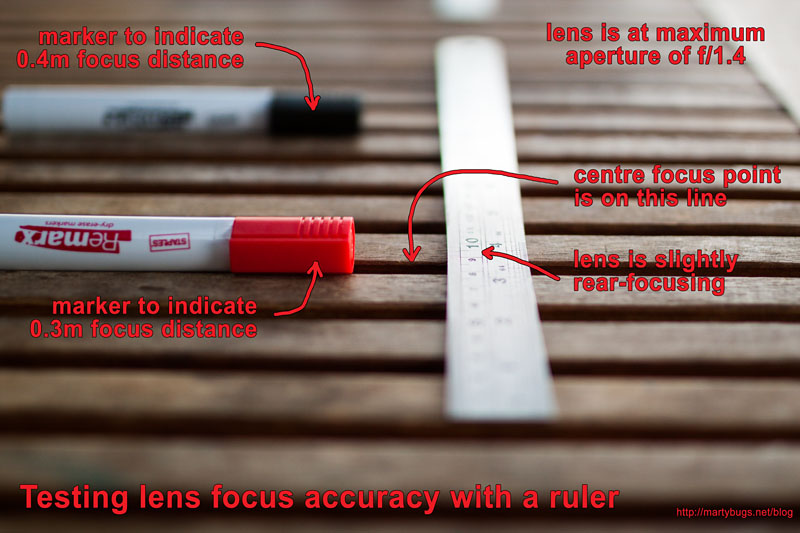
I used Sigma Optimisation Pro version 1.1.0 on my PC running Windows 7 Pro x64, to calibrate my Sigma 35mm f/1.4 DB HSM lens for Canon.
After connecting the USB dock to my PC, the Sigma Optimisation Pro software first checks for updated firmware for the USB dock, then checks for updated firmware for the lens that is attached to the dock.
The Sigma software initially had issues communicating with the USB dock when I connected the USB cable to my PC, first through the USB hub in one of my Dell monitors, and then via a USB extension cable.
After checking for updated lens firmware, the software would hang while displaying a message saying
My Sigma 35mm f/1.4 DG lens firmware was already at the latest release, namely 1.02 (A012), so no firmware upgrade was required.
When first connecting a lens to your computer, the Sigma software will show you information about the lens, including the serial number (blurred in the screenshot below), and will then read the current settings from the lens.
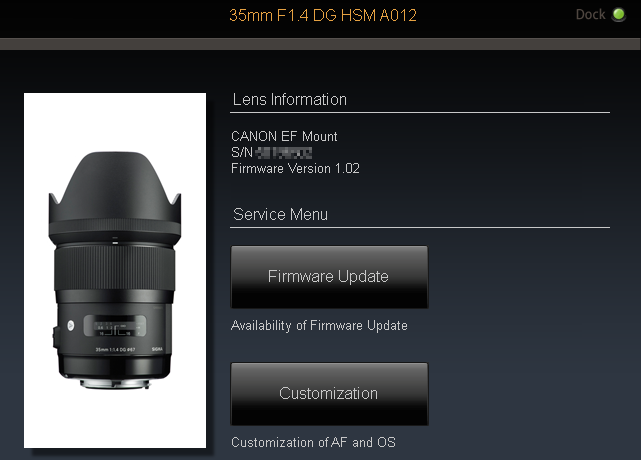
Compatible prime lenses allow focus adjustments to be set at four different focus distances:
- 0.3 metres
- 0.4 metres
- 0.7 metres
- infinity
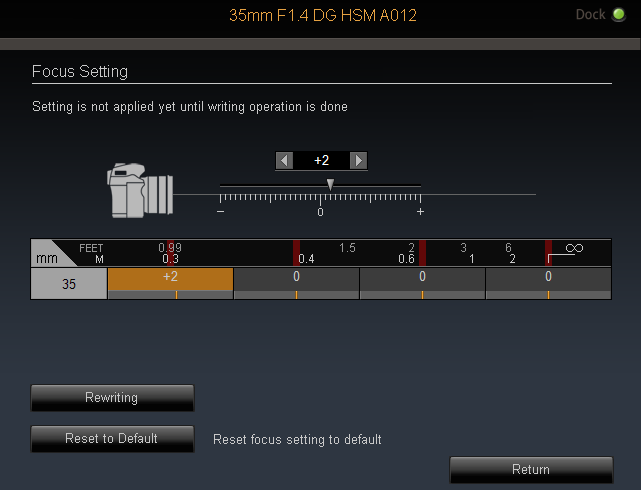
After several iterations of testing and applying adjustments, I settled on the following adjustments:
| focus distance | adjustment |
| 0.3 metres | +2 |
| 0.4 metres | -1 |
| 0.7 metres | +3 |
| infinity | 0 |
The Sigma USB dock gives photographers the flexibility to fine-tune the operation of their compatible Sigma lenses. It provides a lot more flexibility than micro-adjustments in the camera body (a single adjustment that applies to all focal lengths and focus distances), by allowing focus adjustments at multiple focus distances, and for zoom lenses, at multiple focal lengths.
The documentation isn't particularly good, but there are numerous walk-throughs and tutorials available on the internet describing the calibration process in more detail.
I found the process a little tedious, as you need to take some test photos at each of the focus distances (and for a zoom lens, this is done at each of 4 focal lengths), review the photos, remove the lens from the camera and connect it to the dock, run the Sigma Optimisation Pro software, want for it to check for updated dock firmware, and for updated lens firmware, then apply some adjustments, remove the lens from the dock and put it back on your camera, take some more test photos, and repeat until you are satisfied.
The lack of a standard micro-USB or mini-USB connector on the dock is annoying. I normally have several micro-USB and mini-USB cables on my desk, for connecting various devices to my computer, but need to use the Sigma cable for connecting the dock (via a UC-E6 proprietary plug) to my PC.
Is the USB dock a solution by Sigma to their somewhat dubious focus accuracy and quality control? Or is this a market-changing product that will be embraced by photographers?
I think it's the latter, as many serious photographers do calibrate their lenses, and the Sigma USB dock gives them a lot more flexibility than was previously possible, as they can now calibrate their Sigma lenses to their own liking.
Being able to upgrade the firmware in compatible Sigma lenses is also useful, as Sigma may release new versions of firmware for their lenses to resolve possible compatibility issues with Sigma lenses and future models of Canon, Nikon and Pentax camera bodies, as well as fixing issues and/or adding new features and functionality. Which other manufacturer provides that level of configurability and future-proofing of their lenses?
It also raises some interesting possibilities - how long will it be before someone figures out how to use the Sigma USB dock to customise firmware and settings in other (non-Sigma) lenses?
In summary, I think the Sigma USB dock is a great idea, and will be a very useful tool for any serious photographer using Sigma lenses.
There are multiple versions of the Sigma USB Dock - all available for USD$59:
- Sigma USB Dock for Canon mount lenses
- Sigma USB Dock for Nikon mount lenses
- Sigma USB Dock for Sigma mount lenses
addendum: Sigma have published a tutorial for using the USB dock on their website. The instruction manual for the Sigma Optimization Pro software is also available online.
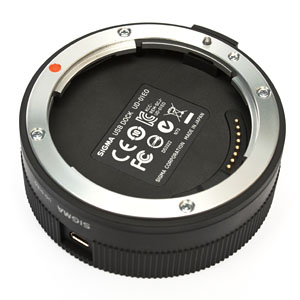
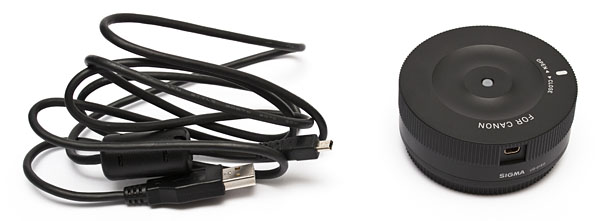
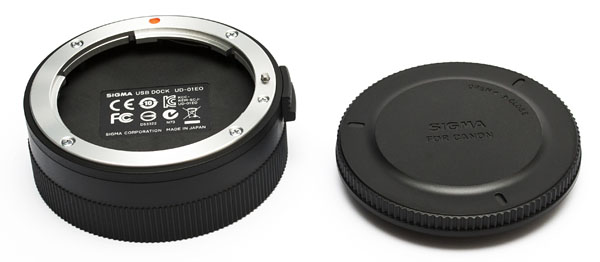
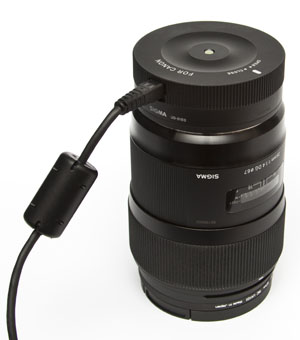
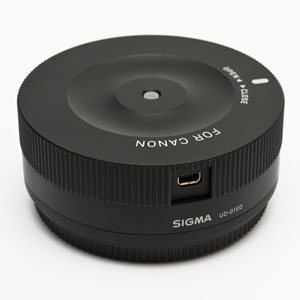
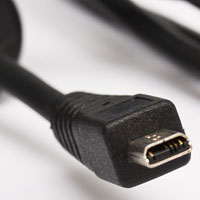



great article! i have one question: can i use any uc-e6 connector usb cable to connect my sigma dock with a pc or do i need a special uc-e6 kable? i bought a used dock without cable and now i have a problem in finding the right cable.
thanks a lot, marco :)